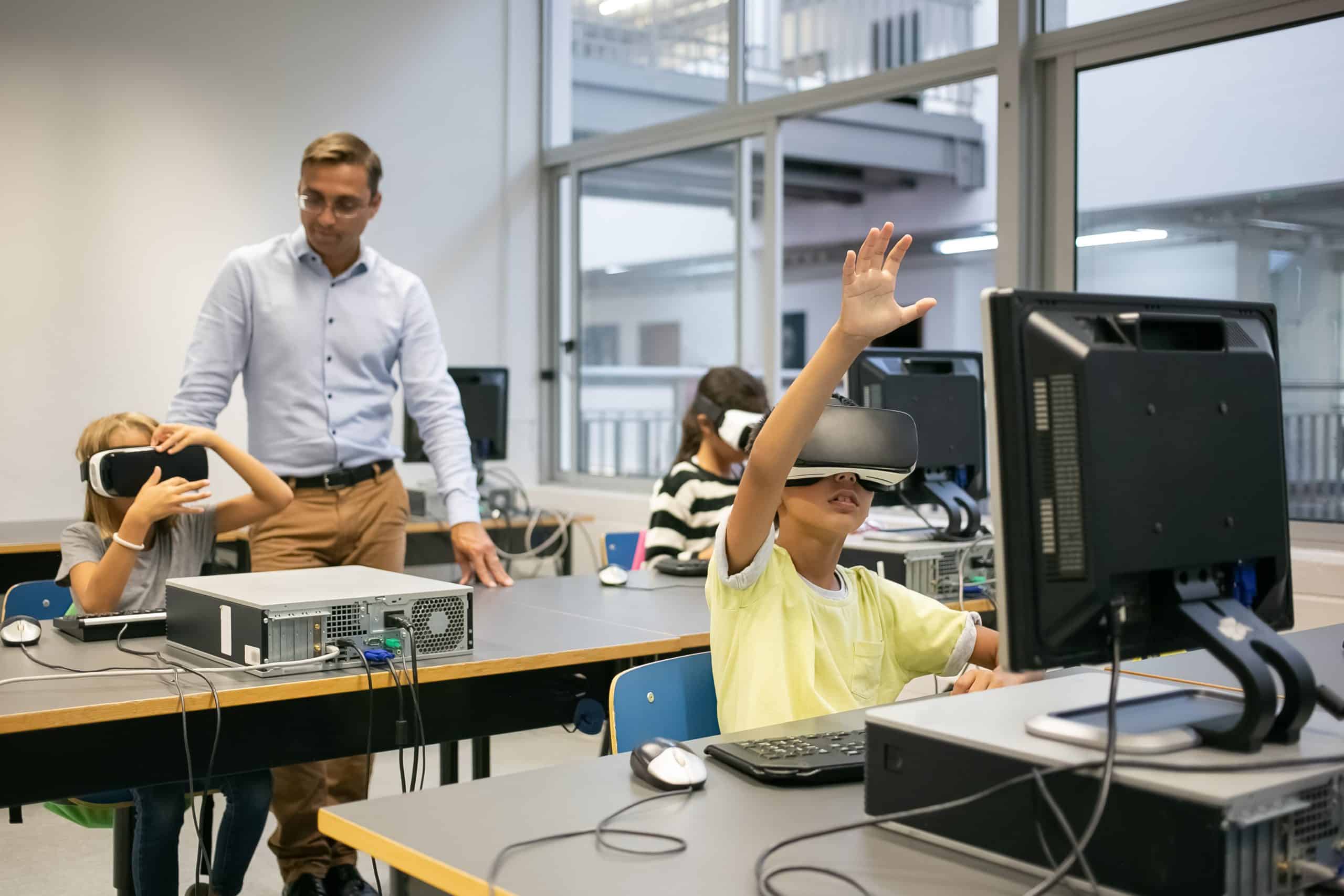Personalized learning through artificial intelligence: a new frontier

Personalized learning through artificial intelligence tailors educational experiences to individual needs, enhancing engagement and learning outcomes while posing challenges like the need for teacher training and data privacy concerns.
Personalized learning through artificial intelligence could be a game-changer for students and educators alike. Imagine a classroom where every lesson is tailored to individual learning paces and styles. Are you curious about how this can reshape education?
Understanding personalized learning
Understanding personalized learning is vital in today’s educational landscape. It involves tailoring the learning experience to meet individual student needs, allowing each learner to progress at their own pace.
In this approach, educators leverage various tools and techniques to ensure that learning is engaging and effective. Personalized learning is not just about technology; it’s about understanding how to provide each student with the unique support they require.
The Core Elements of Personalized Learning
To grasp the concept further, we need to explore its core elements:
- Individual Learning Plans: Each student has a tailored plan that considers their strengths, weaknesses, and interests.
- Flexible Learning Paths: Students can choose how they wish to learn, whether through hands-on projects, online resources, or group work.
- Ongoing Assessment: Regular feedback allows students to track their progress and adapt their learning strategies accordingly.
In addition to these elements, technology plays a significant role. Educators can use data analytics to track student engagement and performance, ensuring that lessons are adjusted to fit learning styles and needs. Using intelligent learning systems, teachers can monitor which areas students struggle with and provide supplementary material or adjust instructional methods as needed.
Benefits of Understanding Personalized Learning
Personalized learning offers numerous advantages:
- Increased Engagement: Students are more motivated when lessons resonate with their interests.
- Improved Outcomes: Tailored instruction often leads to better academic performance.
- Enhanced Skills: Students develop critical thinking and self-management skills through personalized strategies.
By understanding personalized learning, educators can foster environments where every student has the opportunity to succeed. It shifts the focus from traditional teaching methods, promoting a culture that values each learner’s journey.
The role of artificial intelligence in education

The role of artificial intelligence in education is becoming more essential as technology advances. AI can help tailor learning experiences to each student, making education more effective and engaging.
By using AI tools, teachers can identify individual learning styles and adapt their teaching methods accordingly. This approach makes lessons more relevant and interesting for students.
Key Functions of AI in Education
AI performs several key functions that benefit both educators and students:
- Personalized Learning: AI analyzes data from students to create customized learning plans.
- Intelligent Tutoring Systems: These systems provide additional help where students struggle with concepts.
- Automation of Administrative Tasks: AI can handle scheduling and grading, freeing up teachers’ time.
With AI, students receive immediate feedback, allowing them to understand mistakes and learn from them quickly. This instant interaction keeps learners engaged and motivated, creating a more dynamic classroom environment.
Challenges of Implementing AI
Although there are many benefits, some challenges exist. The implementation of AI technology may require significant training for teachers. Additionally, schools need to invest in resources and infrastructure. Data privacy is another concern, as schools must protect students’ information while using AI tools. It’s crucial to find a balance that maximizes the benefits of AI while ensuring student safety.
As artificial intelligence continues to evolve, it is transforming education in many positive ways. By incorporating AI, educators can provide students with interactive and personalized learning experiences. This transformation promises better academic outcomes and a more engaged learning process for all.
Benefits of AI-driven personalized learning
The benefits of AI-driven personalized learning are remarkable and can transform how students engage with their education. With AI, lessons become more relevant and tailored to each learner’s preferences and needs.
One of the major advantages is enhanced engagement. When students learn at their own pace and through methods that resonate with them, they are more likely to stay focused and interested. This approach fosters a deeper connection to the material being studied.
Key Advantages of AI in Personalization
AI offers several key advantages that stem from its ability to analyze and adapt to student behavior:
- Customized Learning Experiences: Each student receives a unique path, accommodating their strengths and weaknesses.
- Immediate Feedback: AI systems provide real-time assessments, allowing students to understand their mistakes instantly and correct them.
- Increased Accessibility: Learners with diverse needs can access tailored resources that support their learning styles.
By focusing on personalized learning, educators can ensure that every student receives the attention they deserve. This also promotes a sense of ownership over their learning process, motivating students to take charge of their education.
Fostering Independence and Responsibility
AI-driven personalized learning encourages students to develop essential skills such as self-discipline and critical thinking. As students engage with materials tailored to their growth, they learn how to manage their time and prioritize tasks effectively. This independence is crucial for their future academic and professional success.
Moreover, teachers can utilize data insights from AI to support students better. They can identify patterns in learning behaviors and adjust their teaching strategies accordingly. This ongoing adjustment process not only enhances students’ learning experiences but also fosters a collaborative environment where students feel supported and understood.
Challenges in implementing AI in classrooms

Implementing AI in classrooms comes with several challenges that educators and administrators must navigate. While the benefits are significant, understanding the hurdles is equally important for a successful integration.
One of the primary challenges is the need for teacher training. Educators must learn how to effectively use AI tools, which can require time and resources. Many teachers may feel overwhelmed by new technology, causing resistance to change.
Infrastructure and Resources
Another critical hurdle is the lack of adequate technology infrastructure. Schools need the right tools and resources to support AI programs. Without reliable internet access and updated hardware, the effectiveness of AI-driven learning can be significantly reduced.
- Funding Issues: Schools often face budget constraints, making it difficult to invest in necessary technology.
- Technical Support: Ongoing support is crucial to address issues and ensure AI systems run smoothly.
- Data Privacy Concerns: Protecting student data during AI implementation is a major priority, with strict guidelines needing to be followed.
Furthermore, a significant concern for many educators is data privacy. Schools must ensure they manage student data responsibly while utilizing AI tools. This includes being transparent about how data is collected and used, which requires clear communication with students and parents.
Addressing Resistance to Change
Resistance to change can also be a barrier. Some educators may hesitate to adopt AI technologies, fearing they will replace traditional teaching methods. However, AI is meant to enhance, not replace, the crucial human aspects of teaching.
In conclusion, while implementing AI in classrooms poses several challenges, these hurdles can be overcome with the right planning and support. Creating a strategy that addresses training, infrastructure, and privacy can lead to successful integration of AI into the educational landscape.
Future trends in personalized learning with AI
The future trends in personalized learning with AI are shaping an exciting landscape in education. As technology continues to advance, we can expect to see significant changes in how students learn and engage with content.
One emerging trend is the increasing use of adaptive learning technologies. These systems use algorithms to tailor educational experiences to the needs and pace of individual learners. By analyzing data from student interactions, AI can modify lessons in real-time, offering challenges or support as needed.
Emphasis on Data Analytics
Data analytics will play a major role in shaping personalized learning. By collecting data on student performance, preferences, and engagement levels, educators can gain insights that inform instructional strategies.
- Identifying Learning Gaps: AI can help teachers quickly pinpoint areas where students struggle.
- Creating Tailored Resources: Teachers can develop specific materials that align with the unique needs of their class.
- Improving Engagement: Understanding when students are most engaged can help design better learning experiences.
Furthermore, each student’s preferences influence how AI develops learning paths. By recognizing these preferences, systems can optimize educational experiences, resulting in higher motivation and success in mastering concepts.
Integration of Virtual and Augmented Reality
Another exciting trend is the integration of virtual and augmented reality (VR and AR) into personalized learning. These technologies provide immersive experiences that enhance engagement and understanding. They allow students to explore complex concepts in an interactive environment, making learning more enjoyable.
As schools adopt these tools, we may witness classrooms transformed into 3D environments where students can learn through exploration. This innovative approach to education further exemplifies how AI can enrich learning experiences.
As we explore the exciting landscape of personalized learning with AI, it becomes clear that the future of education is bright. The integration of AI technologies can enhance the learning experience, making it more tailored and engaging for each student.
While challenges exist, such as the need for proper training and infrastructure, the potential benefits significantly outweigh the hurdles. With ongoing advancements in AI, we are paving the way for educational environments that foster creativity and independence. Embracing these changes will not only support students in their learning journeys but also prepare them for the future.
FAQ – Frequently Asked Questions about AI in Personalized Learning
What is AI-driven personalized learning?
AI-driven personalized learning uses artificial intelligence to tailor educational experiences to meet the unique needs of each student.
How does AI enhance student engagement in the classroom?
AI enhances student engagement by providing customized learning paths and immediate feedback, which keeps students motivated and involved.
What challenges are associated with implementing AI in education?
Challenges include the need for teacher training, adequate technology infrastructure, and addressing data privacy concerns.
What future trends can we expect in personalized learning with AI?
Future trends may include more adaptive learning technologies, increased use of data analytics, and integration of virtual and augmented reality in classrooms.





